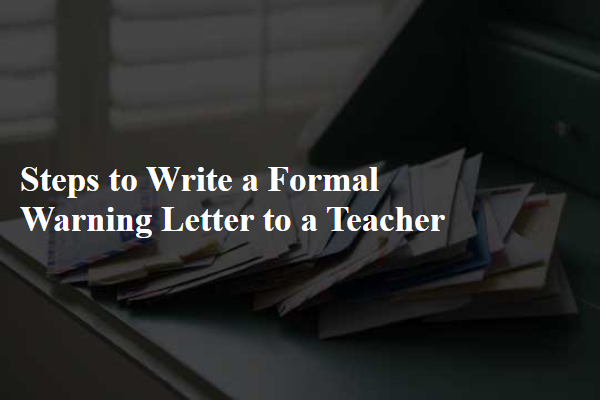
Begin by clearly stating the purpose of the letter and specifying the behavior or issue that requires attention. Provide factual details and evidence to support the concerns while maintaining a professional and respectful tone. Conclude by outlining the expected improvements, potential consequences if the behavior continues, and offering support for corrective action.
Purpose of the Formal Warning Letter
Writing a formal warning letter to a teacher requires a clear and professional tone. The letter should address specific concerns regarding the teacher's conduct or performance.
Begin by stating the purpose of the letter and referencing any previous discussions or warnings. Clearly describe the unacceptable behavior or issue with factual examples. Conclude with expectations for improvement and potential consequences if the behavior continues.
Identification of the Teacher
Writing a formal warning letter to a teacher requires clarity, professionalism, and adherence to school policies. The letter must address specific issues while maintaining respect and legal compliance.
- Identify the Issue - Clearly define the reason for the warning, citing specific incidents or behaviors.
- State Expectations - Outline the expected professional standards and improvements required from the teacher.
- Specify Consequences - Detail potential disciplinary actions if the issues are not addressed within a given timeframe.
Description of the Misconduct or Issue
What are the essential steps to write a formal warning letter to a teacher? Begin by clearly identifying the issue or behavior that requires attention. Use specific examples and maintain a professional tone throughout the letter.
How can you structure the introduction of the warning letter? Start with a formal greeting and state the purpose of the letter concisely. Make sure to mention the teacher's name and position for clarity.
What details should be included when describing the problem? Provide a factual description of the incidents or conduct that violates school policies. Avoid personal opinions and focus on objective evidence.
How should expectations and consequences be communicated in the letter? Clearly outline the standards the teacher is expected to meet moving forward. Specify potential consequences if the behavior continues or does not improve.
What is the best way to conclude a formal warning letter? End with a statement encouraging improvement and offering support if needed. Include contact information for follow-up discussions or clarification.
Reference to Relevant Policies
Writing a formal warning letter to a teacher involves clearly identifying the issue or behavior that requires correction. The letter should state specific examples, outline the expectations, and explain potential consequences if the behavior continues. It must maintain a professional tone while emphasizing the importance of improvement for the benefit of the educational environment.
Previous Warnings or Discussions
Writing a formal warning letter to a teacher requires a clear and professional approach. The letter should state the specific concern or behavior that needs to be addressed.
Include detailed observations or incidents to provide context for the warning. Use respectful language while outlining the expectations for improvement.
Expected Standards of Behavior
Writing a formal warning letter to a teacher requires clarity and professionalism. This document should clearly address the concern and outline expected improvements.
- Identify the issue - Clearly state the specific behavior or performance problem observed.
- Provide evidence - Include factual details or incidents that support the warning.
- Specify consequences - Explain potential outcomes if the issue is not corrected.
Ensure the tone remains respectful while maintaining a firm stance on the expectations set for the teacher.
Required Actions for Improvement
Writing a formal warning letter to a teacher requires clarity and professionalism. Begin by stating the purpose of the letter and referencing specific incidents or behaviors that prompted the warning.
Detail the expectations and standards the teacher must meet moving forward. Include potential consequences if the issues are not addressed.
Timeline for Compliance
Writing a formal warning letter to a teacher requires clear identification of the issue, specifying the expected improvements, and outlining potential consequences if the behavior continues. Begin with a professional salutation and summarize the problem with concrete examples related to job performance or conduct. Conclude the letter by encouraging corrective action and offering support for improvement while maintaining a respectful and firm tone.
Consequences of Non-Compliance
| Step | Description |
|---|---|
| 1. Identify the Issue | Clearly define the specific behavior or performance problem that requires a formal warning. Use documented incidents or observable facts. |
| 2. Review School Policies | Examine relevant institutional rules, codes of conduct, or employment contracts to ensure the warning letter aligns with organizational standards. |
| 3. Write a Clear Subject Line | Use a concise subject such as "Formal Warning Regarding Professional Conduct" to immediately communicate the letter's purpose. |
| 4. Address the Teacher Properly | Begin with a formal salutation including the teacher's full name and title to maintain professionalism. |
| 5. State the Purpose of the Letter | Specify that this communication serves as a formal warning related to the identified issue or misconduct. |
| 6. Describe the Incident(s) in Detail | Provide objective and factual information about the incidents leading to the warning. Include dates, times, and any witnesses if applicable. |
| 7. Reference Relevant Policies or Expectations | Cite the specific policies, codes, or professional standards that have been violated to support the warning's validity. |
| 8. Explain Consequences and Expectations | Outline the potential repercussions if the behavior continues and detail the improvements or corrective actions expected. |
| 9. Offer Support or Resources | Mention available assistance such as mentoring, training, or counseling to encourage professional development. |
| 10. Closing and Signature | End with a professional closing statement and include the name, position, and signature of the relevant authority issuing the letter. |
Contact Information for Further Discussion
Writing a formal warning letter to a teacher requires clarity, professionalism, and a structured approach. The purpose is to address concerns while maintaining respect and compliance with school policies.
- Identify the Issue - Clearly specify the behavior or incident prompting the warning to provide context and justification.
- Detail Relevant Policies - Reference school rules or professional standards that have been violated to establish accountability.
- Outline Consequences and Expectations - Describe the potential repercussions and set clear expectations for future conduct to guide improvement.



Comments